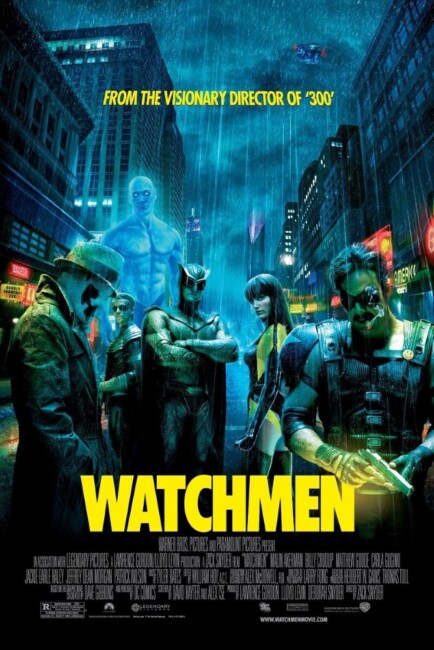USA. 2009.
Crew
Director – Zack Snyder, Screenplay – David Hayter & Alex Tse, Based on the Graphic Novel Watchmen (1986-7) by Dave Gibbons and [uncredited] Alan Moore, Producers – Lawrence Gordon, Lloyd Levin & Deborah Snyder, Photography – Larry Fong, Music – Tyler Bates, Visual Effects Supervisors – Jeremy Burns, David Cameron & Linden Wineland Johnson, Visual Effects – CIS Hollywood, Imageworks India, Intelligent Creatures (Supervisor – Lon Molnar), New Deal Studios (Supervisor – Ian Hunter), The Moving Picture Company (Supervisor – Jessica Norman) & Sony Pictures Imageworks (Supervisor – Peter G. Travers), Special Effects Supervisor – Joel Whist, Makeup Effects Supervisor – Greg Cannom, Makeup Effects – Drac Studio, Production Design – Alex McDowell. Production Company – Paramount/Warner Brothers/Legendary Pictures/DC Comics
Cast
Patrick Wilson (Dan Dreiberg/Nite Owl II), Malin Akerman (Silk Spectre II/Laurie Jupiter), Jackie Earl Haley (Rorschach/Walter Kovacs), Billy Crudup (Dr Manhattan/Jon Osterman), Matthew Goode (Adrian Veidt/Ozymandias), Jeffrey Dean Morgan (Edward Blake/The Comedian), Carla Gugino (Sally Jupiter/Silk Spectre), Matt Frewer (Edgar Jacobi/Moloch), Stephen McHattie (Hollis Mason/Nite Owl), Laura Menell (Janey Slater), Robert Wisden (Richard Nixon), Nhi Do (Vietnamese Girl)
Plot
April 1985. Edward Blake, alias the masked crime-fighter The Comedian, is thrown out his apartment window several stories to his death. The masked vigilante Rorschach investigates and then takes it upon himself to visit each of his four remaining colleagues from the now defunct superhero team The Watchmen, warning them that they too might be targets. These include Dan Dreiberg, the retired hi-tech hero known as Nite Owl; Adrian Veidt, formerly Ozymandias, the most intelligent man in the world who has publicly revealed his identity and how heads a massive corporation; and Laurie Jupiter, who fought as the Silk Spectre, and her boyfriend the physicist Jon Osterman, who became known as Dr Manhattan after a particle physics accident left him with vast powers, including the ability to teleport, rearrange matter and see all time simultaneously. Laurie feels that Dr Manhattan is evolving so far beyond humanity that she leaves him and moves in with Dan. Dr Manhattan is shocked during a tv interview to learn that all those who were associated with him are now dying of cancer. He leaves Earth and builds a base for himself on Mars. As the threat of nuclear war between the USA and the Soviet Union escalates, Laurie pleads with Dr Manhattan to reengage with his humanity and intervene. At the same time, Dan and Laurie put their costumes back on and join Rorschach in trying to find who is behind the murder of The Comedian.
When the promotional trailer for Watchmen claimed that it was “based on the greatest comic-book of all time,” this was pure hyperbole, least of all the trailer’s attempt to inflate such an unsourced claim to the level of an objective statement. Nevertheless, it is a statement that a good many comic-book fans believe to be true. Watchmen was published as a twelve-issue graphic novel by DC Comics between 1986 and 1987. It soon became a word-of-mouth hit and grew into an undisputed cult classic. Watchmen came as part of a revision that the superhero comic-book underwent in the mid-1980s. This included other works like Frank Miller’s The Dark Knight Returns (1986) and DC’s Crisis on Infinite Earths (1985-6), which served to deconstruct and darken the traditional image of the comic-book superhero.
With Watchmen, Alan Moore took various superheroic types and asked what would happen if they existed in the real world and crafted them with more muddied moral complexities than the usual black-and-whites that superhero comic-books operated by. Watchmen was set in an alternate world USA where the presence of superheroes had changed world events – as we can see in the film, Dr Manhattan and The Comedian helped win the Vietnam War and the end of the film imposes a solution to the Cold War.
This was also the point that the graphic novel began to emerge as an entity – the comic-book that didn’t want to be slapped with the label ‘comic-book’ and was usually centred around self-contained stories of a more adult nature. Alan Moore has been scathing about the changes in the comic-book that came after Watchmen (and The Dark Knight Returns) – a plethora of dark, morally ambiguous and grimly driven superheroes and comic-books that were drawn with grittily realistic artwork, dealt with adult sensibilities and where a frequent degree of violence dominated. This approach came to be echoed by numerous comic-books through the late 80s and onwards. Indeed, this look has become so prevalent with film-adapted superheroes that it seems impossible for Watchmen the film to replicate the freshness of approach that Alan Moore’s comic-book had when it appeared.
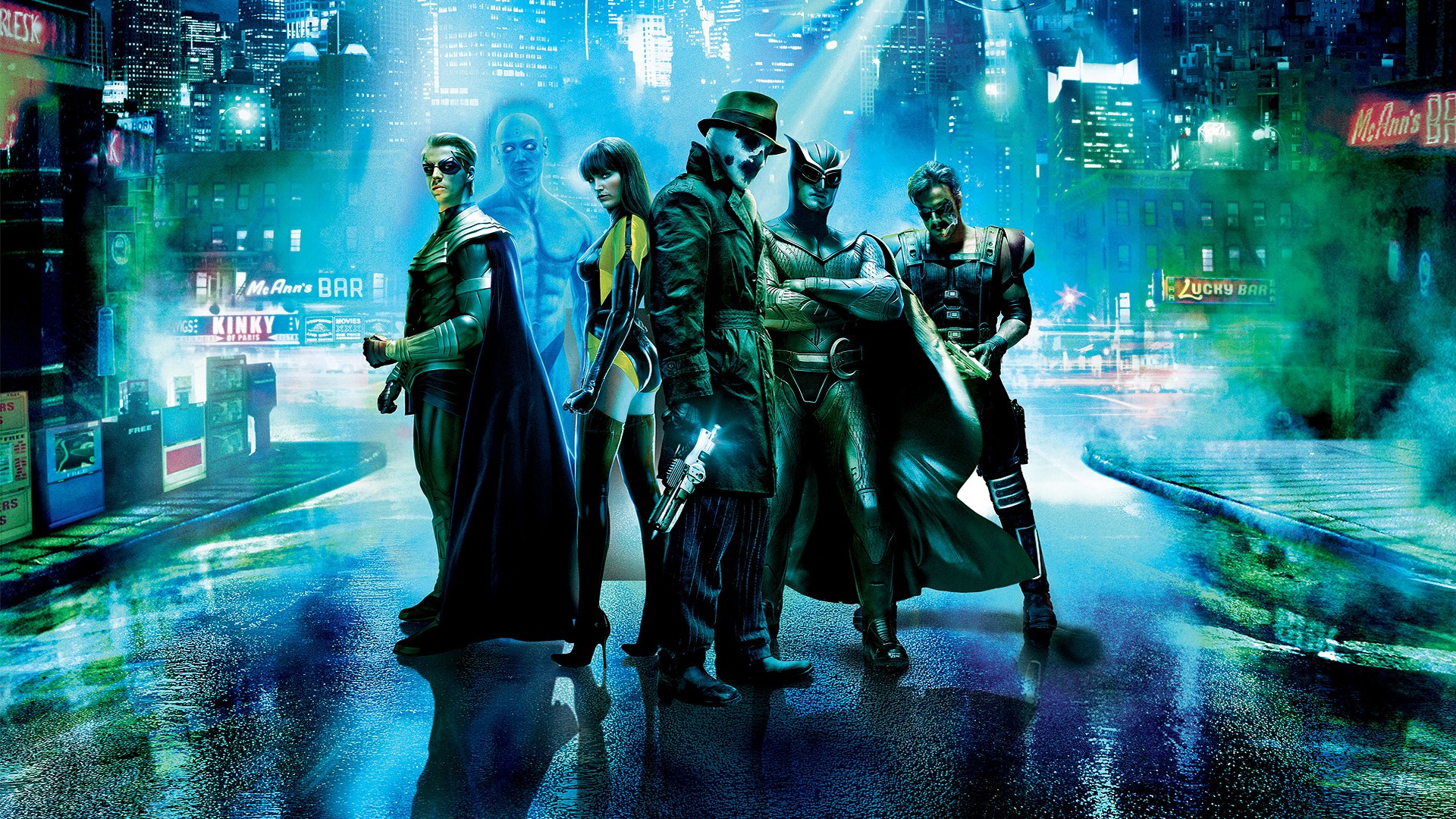
Watchmen came from British comics writer Alan Moore, along with artist Dave Gibbons. Alan Moore has become a legendary figure. Moore began his professional career working for UK’s 2000 AD magazine where he gained prominence with The Ballad of Halo Jones (1984-6), as well as independent works such as V for Vendetta (1982-8) and his reworking of Marvelman/Miracleman in 1982. These brought Alan Moore to the attention of American publishers and he was hired by DC to revamp Swamp Thing in 1983 where his darkly complex stories succeeded in turning it into a cult work. In Swamp Thing, Moore also created the character of the occult investigator John Constantine, who later gained his own comic-book with the popular Hellblazer (1988– ). This period also produced Watchmen for DC and the classic Batman graphic novel The Killing Joke (1988) but at the same time as his acclaim grew, Moore quit DC following a dispute. Moore began to work independently thereafter, where he has produced such works as the Jack the Ripper tale From Hell (1991-6); the ongoing The League of Extraordinary Gentlemen (1999– ) series bringing together various characters from Victorian fiction; and Lost Souls (2006), an erotic work combining Alice of Wonderland and Peter Pan.
A film version of Watchmen has been planned almost ever since the comic-book was first published. Sam Hamm, the screenwriter of the Tim Burton Batman (1989), was put to work under producer Joel Silver. Terry Gilliam was involved in a proposed production towards the end of the 1980s but Gilliam could never find a means to tell the story at commercial film length and backed out, saying the only way he could think of adapting Watchmen was as a tv mini-series. Versions were planned amid the big screen superhero renaissance of the 2000s under directorial names like Darren Aaronofsky of Pi (1998), The Wrestler (2008) and Black Swan (2010) fame, Paul Greengrass of United 93 (2006) and the Bourne sequels, even at one point the ghastly possibility of Michael Bay of Transformers (2007) notoriety, someone whose bludgeoning sensibilities could not be further away from the moral complexities of Watchmen.
This production was eventually mounted under Zack Snyder, who was a hot director on the back of the remake of Dawn of the Dead (2004) and the adaptation of Frank Miller’s graphic novel 300 (2007). 300 showed Snyder to have an acute genre sensibility and an enormous respect for the comic-book medium where he directly modelled his camera set-ups on the panels of the graphic novel. The script for Watchmen comes from David Hayter who also wrote the first two X-Men films.
Alan Moore has enjoyed a high profile in terms of screen adaptations of his works with the likes of From Hell (2001), The League of Extraordinary Gentlemen (2003), Constantine (2005) (based on Hellblazer), V for Vendetta (2006), the Mogo Doesn’t Socialize and Tygers episodes of Green Lantern: Emerald Knights (2011) and Batman: The Killing Joke (2016), as well as the scripts for two original films Show Pieces (2014) and The Show (2020). However, Moore felt betrayed by these film adaptations and refused to accept any screen credit on the Watchmen film and issued vociferous denials when producers made claim that he had approved of the adaptation, even when Zack Snyder stated that he hoped the worst case scenario would be that Moore would think the film was not too bad a version.
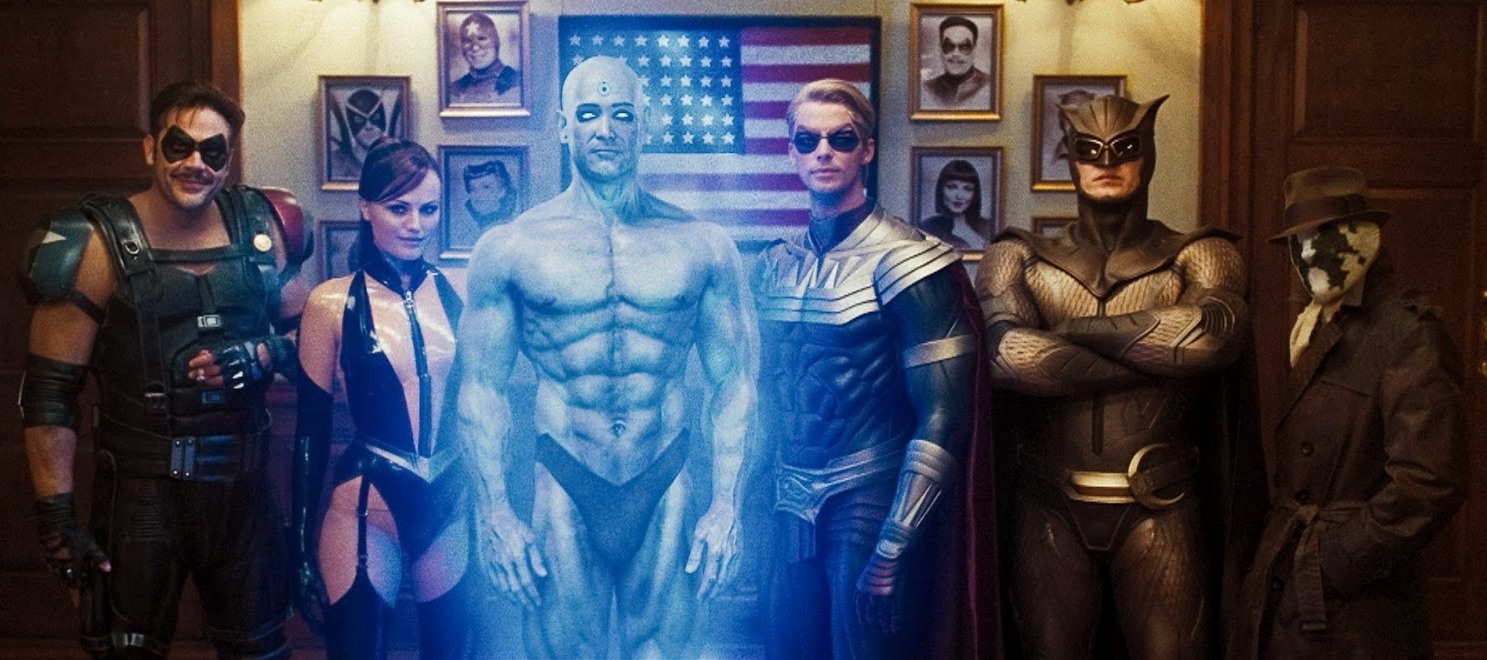
Alan Moore’s feelings on the matter aside, the film is exceedingly faithful to the graphic novel. The phrase that was much bandied about in the promotion to the point of being meaningless is that Watchmen was considered unfilmable. The major basis of this statement would appear to be the sprawling nature of the story. Much of the information about the background of the alternate world and characters was relayed through documents interspersed through each issue, for instance. Furthermore, Alan Moore’s story was non-linear, flipping back and forward between the present, the characters’ pasts and political events – something that is preserved in the film.
The film’s major change comes in the nature of Adrian Veidt’s world-changing plan at the end – in the film, he fakes a nuclear attack to make it seem like it came from Dr Manhattan, while in the comic-book he creates a fake alien invasion. Also missing from the film is Tales of the Black Freighter, a pirate comic-book that is read by characters throughout the story – however, Zack Snyder filmed this as its own entity and released it amid the extras on the Watchmen dvd. As with 300, Zack Snyder has based numerous of his camera set-ups on the drawn comic-book panels and an enormous amount of the detail from the original has been preserved. Some authors would sell members of their family for such faithful adaptations of their work.
Visually, Watchmen is a much more standard film than Zack Snyder’s 300, but still no less dazzling a work. There is the sense of watching a genuine epic. One of the best things about Watchmen is knowing that it will be a massive box-office success but one where its successes are not the usual stuff of superheroic films – super-powered beings pounding each other about in displays of mass destruction and special effects – but rather from a story of character depths, moral complexities and questions of world politics. Zack Snyder certainly unleashes a number of fight scenes with the superheroes in action but there are surprisingly fewer of these than one might think and no big slam-bang-wow set-pieces.
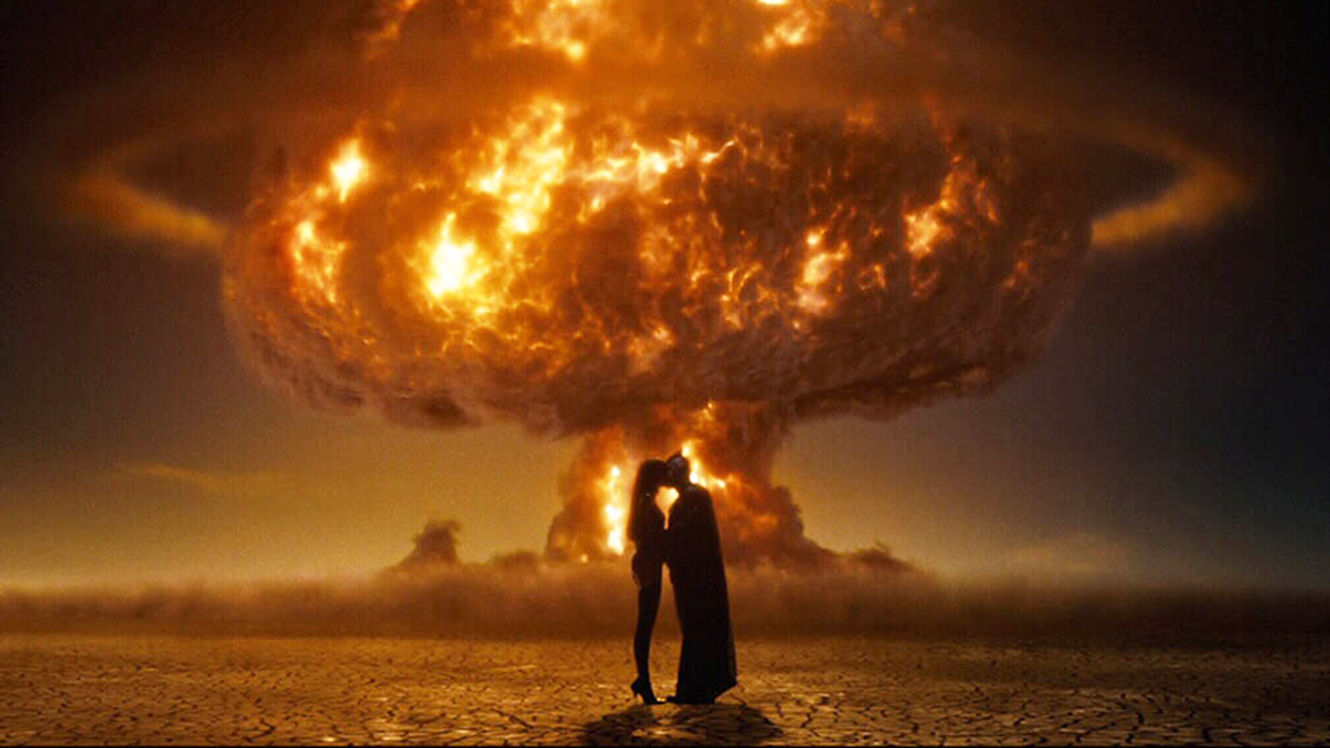
Snyder is also more than happy to keep the darkness of the original to the extent of broaching a less commercial R-rating, including sex scenes between Patrick Wilson and Malin Akerman; a high degree of violence and bloodshed, including the buzzsawing off one criminal’s hands, the hacking open of the head of a paedophile with a meat cleaver and various bullets in the head; as well as a full-frontal nude Dr Manhattan wandering about through much of the film.
A major problem for many of the previous scripters was what to do with the comic-book’s 1980s setting, with many of the other writers struggling about how to update it to the modern era. The film simply sweeps this aside by keeping the setting exactly as it was. There are numerous cute historical background asides with appearances from Robert Wisden as Richard Nixon (in an incredibly unconvincing makeup job), a restaging of the John F. Kennedy assassination (with The Comedian shown as being the shooter on the Grassy Knoll), and cameos from figures like Andy Warhol, Henry Kissinger, Pat Buchanan, Fidel Castro and lesser known people like broadcaster Ted Koppel, journalist Eleanor Clift and business magnate Lee Iacocca.
Aside from some minor costume changes, the characters are extremely true to the way they were in the comic-book. The dialogue that David Hayter and Alex Tse write, which is almost all taken direct from Alan Moore, positively sings at times. In particular, Rorschach’s voice-over narration, which frames the story through the diary entries, is written as a series of staccato taunts in the pugnacious style of pulp writers like Dashiell Hammett and Mickey Spillane and holds a considerable sense of sardonic humour.
The character that emerges the most fascinatingly is that of Dr Manhattan, the scientist who is evolving beyond human conception. The scenes that Hayter and Tse write where he is interviewed on television or talks to Laurie on Mars, calmly describing how little difference there is between a body that is alive and dead or how Mars gets along perfectly well without human presence, have a hauntingly inhumane perspective in their aloofness.
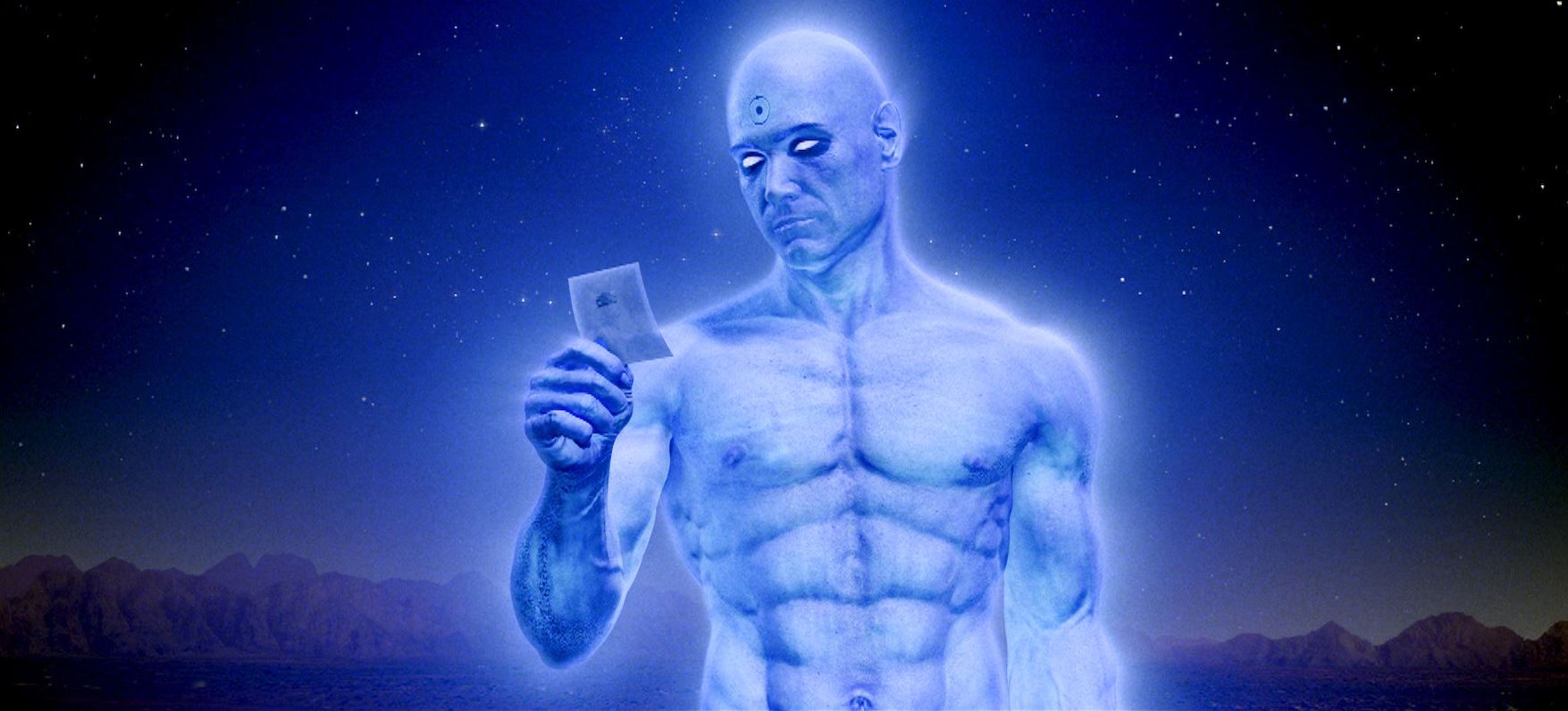
Most successful is the film’s articulation of the essential moral questions that run through the comic-book. It is possible to debate to what extent the characters are based on other superheroes (as many fans do). Less important than the sources of inspiration is the fact that the superheroes embody various comic-book archetypes – Rorschach is the grim loner vigilante who sees the world in black-and-white terms and exacts brutal justice a la Batman and The Punisher; The Comedian represents the superhero who has accepted employ as a government agent a la Nick Fury, Captain America and various of the well-known superheroes during World War II; Nite Owl is a gadgeteer superhero a la Batman; Ozymandias is akin to the pre-Crisis Lex Luthor who was the foremost scientific brain in the world; while Dr Manhattan is conceived as a super-being along the lines of Superman who has incredible powers that set him above mere mortals. (The original Silk Spectre is even made up to look like Betty Page where in doing so Zack Snyder taps into the inherent fetishism that lies beneath many of the scanty costumes that superheroines are outfitted with).
The story does fascinating things in setting these characters in the real world – showing how most are disturbed psychopaths or lead sad and lonely lives. With the character of Dr Manhattan, Watchmen asks the potent question – if one has god-like powers, what is their responsibility towards the rest of humanity and crucially how connected are they to the human race? Overreaching Watchmen is the question of what it would be like in a world where these characters exist – would the cause they fight for necessarily be a just one? The moral point the film reaches where world peace is finally achieved but where the cost of it is Ozymandias having to murder and coldly manipulate his fellow heroes and they having to swallow this for the greater good is a fascinatingly resonant one.
Watchmen was subsequently adapted into the nine-episode tv series Watchmen (2019) and the two-part animated adaptation Watchmen: Chapter I (2024) and Watchmen: Chapter II (2024).
Next up for Zack Snyder was the animated Legend of the Guardians: The Owls of Ga’Hoole (2010); Sucker Punch (2011) about a girl in a psychiatric institution who creates an alternate reality; and the Superman reboot Man of Steel (2013), followed by the DC crossovers Batman V Superman: Dawn of Justice (2016) and Justice League (2017), plus his extended cut of the latter with Zack Snyder’s Justice League (2021), the zombie film Army of the Dead (2021) and the space opera Rebel Moon – A Child of Fire: Part One (2023) and Rebel Moon – Part Two: The Scargiver (2024). Snyder also wrote/produced 300: Rise of an Empire (2014) and produced Suicide Squad (2016), Wonder Woman (2017), Aquaman (2018), Wonder Woman 1984/WW84 (2020), Army of Thieves (2021) and The Suicide Squad (2021).
(Winner in this site’s Top 10 Films of 2009 list. Winner for Best Adapted Screenplay and Best Supporting Actor (Billy Crudup), Nominee for and Best Supporting Actor (Jackie Earl Haley) at this site’s Best of 2009 Awards).
Trailer here


